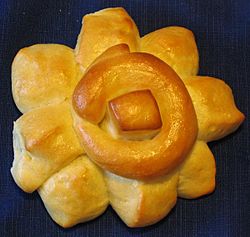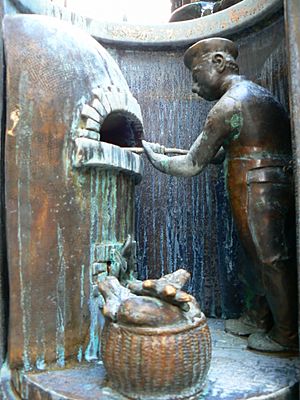Mutschel facts for kids
 |
|
| Type | Bread |
|---|---|
| Place of origin | Germany |
| Region or state | Reutlingen |
The Mutschel is a special star-shaped bread from Reutlingen, Germany. People have been making this bread and celebrating "Mutscheltag" (Mutschel Day) for a very long time. This tradition might have started as early as the 1200s.
Mutscheln are usually shaped like a star. They come in different sizes. Most are about six inches wide. But bakeries sometimes make huge ones, three feet or more across! The most common Mutschel is made from wheat, yeast, a little fat (like butter), and eggs. Sometimes, they are made as sweet breads.
There are a few ideas about how this unique bread shape came to be. One idea is that the tall middle part of the bread looks like the castle on top of the Achalm. This is a hill right next to Reutlingen. The eight points of the star might stand for the old medieval guilds (groups of skilled workers).
Another idea is that the star shape has a Christian meaning. It could represent the Star of Bethlehem. This star guided the Three Kings. A third idea suggests that a baker named Albrecht Mutschler invented the shape. He lived in Reutlingen in the 1300s. This baker was first mentioned in a book from 1435 called Reutlinger Heimatbuch.
Contents
Mutscheltag: A Fun Community Day
Mutscheltag is a special day in Reutlingen. It happens on the first Thursday after Epiphany. On this day, people gather in halls and homes. They play dice games together. The winners of these games get parts or even whole Mutschel breads!
You can join in if you are invited into the group. The "Mutschelspiele" (Mutschel games) are small dice games. Players earn points or tally marks. Some games are won on their own. Other games contribute to a grand total at the end of the night.
Before a game starts, everyone learns what the winner gets. They also hear the rules. The rules can even change between rounds! At first, players might win points. Later, they might win pieces of the Mutschel. If the Mutschel is very big, even the center part is cut into pieces. In later rounds, a lucky player might win a whole Mutschel.
It's fine to eat the bread right there at the event. Butter is often served with it. You can also take your Mutschel home to eat later. If someone has been very lucky, it's nice to share some bread with a friend who wasn't so lucky. Mutscheltag is all about community and sharing. The goal is for everyone to feel happy and like a winner.
Usually, there are lots of Mutschels. So, no one goes home hungry. Everyone gets some bread for the next day. If a loved one cannot come, a friend might visit them. They will bring a Mutschel to share.
Mutschel vs. Pfullingen's Star
In the nearby town of Pfullingen, they have a similar tradition. They have a cake called a "star." The stars from Pfullingen usually have seven points. The Mutschel usually has eight points. Very large Mutschels can even have many sets of eight points.
It's important not to call a Pfullingen star a Mutschel. This could be seen as rude. It touches on an old rivalry between Pfullingen and Reutlingen. However, you can call a Mutschel a "star" without causing offense. It really does look like a star. It is also connected to the tradition of the Three Kings who followed the star to Bethlehem.
Popular Mutschel Dice Games
Here are some common dice games played on Mutscheltag:
Twenty-One
This game uses one die. The first player places the die in front of them with one dot facing up. They pass it to the next player. This player rolls the die and adds their number to the first player's number. They pass the die to the third player, who rolls and adds to the total. The player who reaches 21 or more gets a tally mark. You can play for as long as you like. You decide if the person with the most or fewest tally marks wins.
House Numbers
This game uses three dice. The goal is to get the smallest three-digit "house number." Each player rolls three times. After each roll, you write down the die result. You decide if it goes in the hundreds, tens, or ones place. For example, if you roll a one, you should put it in the hundreds place. This helps make your house number as small as possible. If you roll a six, you should put it in the ones place. The rules can also be changed. Then, the goal would be to roll the biggest possible number.
Sequence
This game uses three dice. If a player does not roll a sequence, they get a tally mark against them. A sequence is numbers like 1-2-3, 2-3-4, 3-4-5, or 4-5-6. Another way to play is like Yahtzee. After the first roll of three dice, a player can keep one or two dice. They can roll the others up to two more times. If they still don't have a sequence after the third roll, they get a tally mark. Play for as long as you want.
Farm Window
This game uses two dice. Only the numbers 3 and 5 count in this game. If players do not roll a 3 or a 5, they receive tally marks against them. You can play this game for as long as you like.
Other Fun Games
- The guard blows from the tower: Players blow a die off an upside-down cup. They compare it with a hidden die under the cup.
- Seven eat like animals
- "Mäxle": While not strictly a Mutschel game, it is sometimes played.


